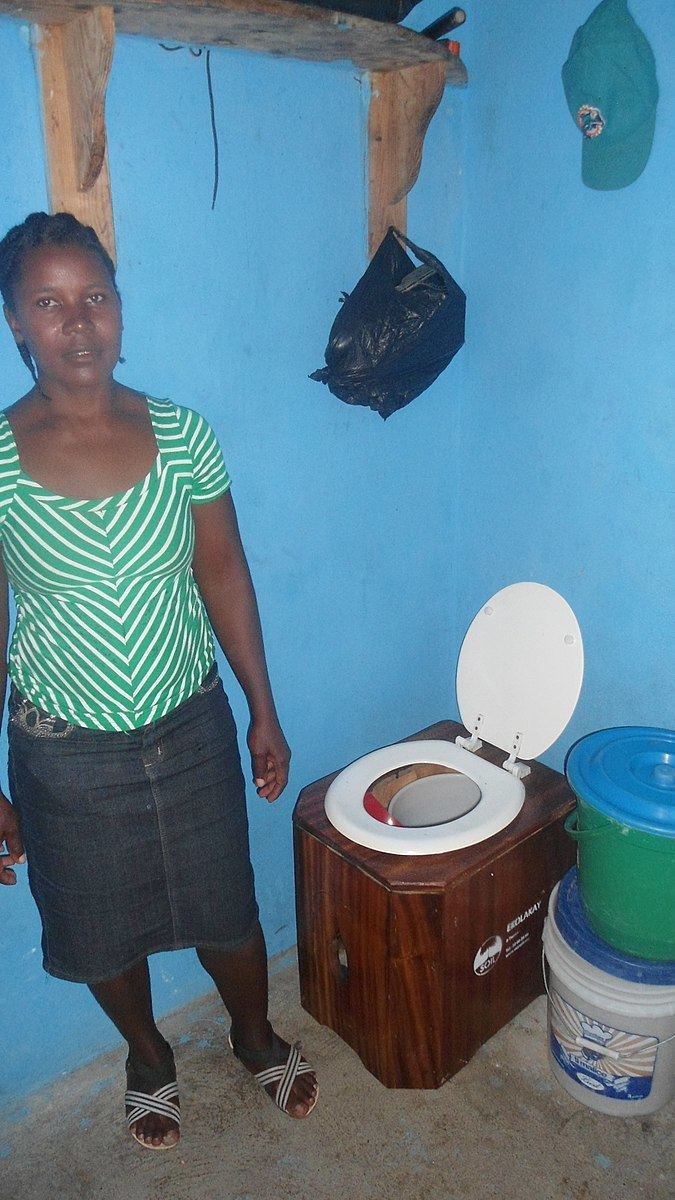 | ||
A portable (or mobile) toilet can be used in a variety of situations, for example in urban slums of developing countries, at festivals, for camping, or on boats. One well-known type of portable toilets are chemical toilets, but other types exist as well, such as urine-diversion dehydration toilets, composting toilets, bucket toilets, freezing toilets and incineration toilets.
Contents
A portable toilet is not connected to a hole in the ground (like a pit latrine), nor to a septic tank, nor is it plumbed into a municipal system leading to a sewage treatment plant; it can, by definition, be picked up and moved. Some portable toilets can be carried by one person, as in the main image, whereas others need heavy lifting equipment such as a truck and winch.
Chemical toilets
A chemical toilet collects human excreta in a holding tank and uses chemicals to minimize the odors. Chemical toilets include those on plane and trains (although many of these are now vacuum toilets), as well as much simpler ones.
Portable camping toilets
A simpler type of portable toilet may be used in travel trailers (caravans, camper vans) and on small boats. One name for them is "camping toilet", but they are also known under brand names that have become generic trademarks. The Oxford English Dictionary lists "Porta Potti" ("with arbitrary respelling") as "A proprietary name for: a portable chemical toilet, as used by campers", and gives mostly American examples from 1968. (The OED gives this proprietary name a second meaning, "a small prefabricated unit containing a toilet, designed for easy transportation and temporary installation esp. outdoors", which Wikipedia covers under chemical toilet.)
The other name common in British English is "Elsan", which dates back to 1924. According to the Camping and Caravanning Club, "Today you will often see campsites refer to their Chemical Disposal Points as Elsan Disposal Points because of the history and popularity of the brand." The Canal and River Trust uses both brand names, in lieu of any unbranded term.
One colloquialism for these simple toilets is the "bucket and chuck it" system, although in fact they no longer resemble an open bucket (see bucket toilet). These are designed to be emptied into sanitary stations connected to the regular sewage system. These toilets are not to be confused with the types that are plumbed in to the vehicle and need to be pumped out at holding tank dump stations.
Urine-diversion dehydration toilets
Portable urine-diversion dehydration toilets are self-contained dry toilets, sometimes referred to as mobile or stand-alone units. They are identifiable by their one-piece molded plastic shells or, in the case of DIY versions, simple plywood box construction. Most users of self-contained UDDTs rely upon a post-treatment process to ensure pathogen reduction. This post-treatment may consist of long-term storage or addition to an existing or purpose-built compost pile or some combination thereof. A post-treatment step is unnecessary in the case of very modest seasonal use.
Others
A bucket toilet and an invalid's commode (a chair enclosing a chamber pot) are basic, simple types of portable toilet, with long histories. Further types that can be regarded as portable are freezing and incineration toilets, as they are neither connected to a sewer system nor to a hole in the ground. Compost toilets can be designed to be portable.
History
Early versions of the "Elsan chemical closet" ("closet" meaning a small room, see water closet, WC, and earth closet) were sold at Army & Navy Stores. Their use in World War II bomber aircraft is described at some length by the Bomber Command Museum of Canada; in brief, they were not popular with either the flying crew or the ground crew.
African-Americans living under Jim Crow laws (i.e. before the Civil Rights Act of 1964) faced dangerous challenges. Public toilets were segregated by race, and many restaurants and gas stations refused to serve black people, so some travellers carried a portable toilet in the trunk of their car.
A slang term, now dated or historic, is a "thunder-box" (OED: "a portable commode; by extension, any lavatory"). The term was used particularly in British India; travel writer Stephen McClarence called it "a crude sort of colonial lavatory". One features to comic effect in Evelyn Waugh's novel Men at Arms:
‘If you must know, it's my thunderbox.’.. He..dragged out the treasure, a brass-bound, oak cube... On the inside of the lid was a plaque bearing the embossed title Connolly's Chemical Closet.
They can still be seen in historic house museums such as Sir George-Étienne Cartier National Historic Site in Old Montreal, Canada.
